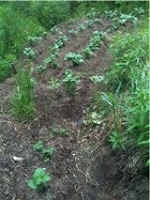06 20 11 How to Identify a Weed
At the same time, the cow parsnip and the fireweed are up in the same garden space. As we have been working on the garden I have been trying to decide how to define what is a weed and what is not. Fireweed is beautiful and technically edible. Cow parsnip surely has its uses, too. Do we remove these plants?
time, the cow parsnip and the fireweed are up in the same garden space. As we have been working on the garden I have been trying to decide how to define what is a weed and what is not. Fireweed is beautiful and technically edible. Cow parsnip surely has its uses, too. Do we remove these plants?
Some things that I used to consider obvious weeds are actually quite useful. Dandelions are a case in point. As a kid I remember digging dandelions out of the lawn with a knife. They were too prolific and tended to crowd out the grass (not a weed) in our lawn. Dandelions seemed to me to be pure weed.
Later I learned that dandelions were supposedly good in salads and very nutritious. This year I actually went to a dinner at a Korean Presbyterian Church where they served the most delicious dandelion salad. I WANT THAT RECIPE! Dandelions may not be stuck on my weed list.
The answer about what is a weed and what is not seems to be a question of which plants we want and which we do not. Unwelcome plants are weeds. Cindee has been pulling daisies like crazy, because they are taking over the perennial flowers in the flower garden. But I do think daisies (and lupine and several other all too prolific flowers) are beautiful; just not when they out-compete other flowers in our flower garden.
The question about what is a weed seems to be less important for plants that grow quickly than for plants that take time. Since our goal is to develop a full ecosystem, we need mature trees, we need shrubs and we need ground cover—and together these elements need to work together to be fruitful. The ground cover grows quickly, so we could change our mind about those plants without too much consequence. But trees take years to grow to where they are big enough to be very fruitful. We have decided that cottonwoods are weeds below our house, but what trees do we want in that space? What are wanted plants and what are weeds?
One of the Jesus’ most famous parables is the Parable of the Weeds (Matthew 13:24-30). In that parable, the landowner discovers that an enemy planted weeds in his wheat field. The owner recognizes that if he goes out and pulls up the weeds, he will inadvertently also affect the roots of the wheat, maybe even pulling them up, too. He therefore leaves the weeds to grow until harvest time, when they will be separated from the wheat and destroyed.
This parable indicates that people can either be good crop or weeds, too, just like plants. We need to live in our context in a way that builds up a fruitful community, but what that will mean always requires paying attention. Lately, the garden has also helped me apply this parable to relationships with people.
 The garden has helped me to realize that all plants have their uses. It is when they are the wrong plant in the wrong place that they cut back on the fruitfulness of the local ecosystem. The gardener culls the weeds, not because they are evil, but because they compete with the fruitful crops in a way that cuts back productivity for the whole system. In another setting, the weed is a beautiful thing.
The garden has helped me to realize that all plants have their uses. It is when they are the wrong plant in the wrong place that they cut back on the fruitfulness of the local ecosystem. The gardener culls the weeds, not because they are evil, but because they compete with the fruitful crops in a way that cuts back productivity for the whole system. In another setting, the weed is a beautiful thing.
For people, there should be an awareness of such things. Are we living in the right setting to contribute to the fruitfulness of our local context? If not, do we need to move to another setting, or do we need to adapt our behavior—a sort of self-pruning—so that we add to the fruitfulness of our setting? In short, are we weeds or are we contributors to our societies and to our world?
And when it comes to pruning, how do we relate to others? How do we assess who we put time with and who we don’t? In a sense there is no such thing as a weed. But there are choices, and we must make them.



Very well said, Curt. I think I was in the weed category more than once in my younger years! Now I see myself as a perennial, growing stronger year by year as my roots spread ever wider and deeper. It's also fun, though, to pose as an annual once in a while--you get to be bright and flashy, then go back "home."
ReplyDelete